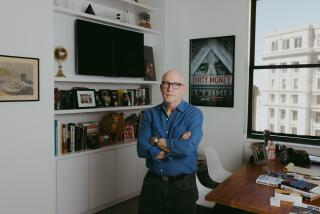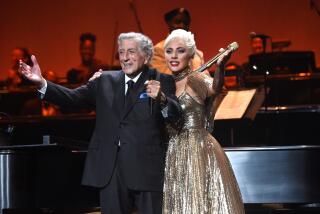MUSIC REVIEW : Benson’s Genius Plays 2nd Fiddle to His Crooning
SAN DIEGO — For fans of the jazz guitar, 1976 was a bad year. That was the year George Benson the guitarist was reborn as George Benson the romantic crooner. On the 1976 album “Breezin’ ” Benson stepped out on vocals on just one tune, but oh, what a difference it made in his life. His version of Leon Russell’s “This Masquerade” became a major hit and helped catapult the album to sales of more than 6 million copies and three Grammys.
Benson’s fate was sealed. Listeners couldn’t get enough of his honey-dripping vocals, and subsequent Benson albums included more and more singing and less and less guitar. But his newest albums--the 1989 “Tenderly,” with former John Coltrane pianist McCoy Tyner, and last year’s “Big Boss Band,” with the Count Basie Orchestra--found Benson getting back to his jazz roots. In concert, however, he still gives his fans what they want.
During the first of two shows Tuesday night at Humphrey’s Concerts by the Bay, Benson concentrated on his swooning crooning. Wearing a white sport coat with black pin-stripes over black pants and a black shirt, Benson had a powerful effect on the women in the front rows. His warm smiles and bedroom eyes evoked many a squeal, and Benson came off more like Luther Vandross’ long lost cousin than one of the world’s great jazz guitarists.
It was the opening night of a six-week tour that will wind up in Europe, and the band took a few tunes to get loose. But this is a tight ensemble, including veteran bassist Stanley Banks, who has recorded several albums with Benson; plus rhythm guitarist (and former San Diegan) Pat Kelley; percussionist Dio Saucedo; drummer Gerry Brown; keyboard player Thom Hall, and pianist and music director David Witham.
Opening with “Breezin,’ ” Benson played a predictable 14-song set that concentrated on music from his popular, post-”Breezin’ ” recordings. A pair of tunes from “Tenderly” were highlights, as Benson let his guitar do a fair amount of talking on the Brazilian-flavored “At the Mambo Inn” and Lennon and McCartney’s “Here, There and Everywhere.”
There’s no question that Benson, who played Humphrey’s on both Tuesday and Wednesday nights, is a superb musician.
On guitar, he is an awe-inspiring technician, a fluid improviser who combines the single-note lines of jazz guitar pioneer Charlie Christian with octave-spaced pairs of notes that pay homage to guitarist Wes Montgomery, Benson’s mentor during the 1960s. As a singer, Benson handles a variety of material with aplomb and commitment.
But Benson himself seems to know where his true genius lies. In the January issue of Downbeat magazine, he told an interviewer that he believes his lasting legacy will be his guitar work. “Here, There and Everywhere” provided the evidence.
His singing was warm, friendly, facile, more than adequate but not sensational. His guitar playing, however, was greased lightning. Benson improvised with the greatest of ease, embroidering the familiar Beatles melody with line after lyrical line.
The long, middle portion of the set was all romance. Beginning with “Love X Love,” Benson delivered some of his sexiest ballads, as Banks and Brown drove the music with a relentless, rhythmic thrust, and Hall provided synthetic horns and strings. Soon, Benson abandoned the guitar entirely, which freed his hands and hips to give suggestive emphasis to “In Your Eyes,” “Feel Like Making Love,” “Shiver,” “Turn Your Love Around” and “Love Ballad.”
After leaving the stage to tremendous applause from a nearly full house, Benson returned for an encore, including the monster hits “This Masquerade” and “On Broadway.”
Benson’s trademark scat-guitar solos on these tunes have become the equivalent of Liberace’s candelabra. You smile with the pleasure of warm memories, but they don’t break new artistic ground.
And that is the most discouraging thing about Benson, circa 1991. He is immensely popular. Humphrey’s promoter Kenny Weissberg estimated he would sell more than 4,000 tickets for Benson’s four shows in the 1,200-seat venue. But, instead of taking the safe, successful route, Benson could be picking up where Wes Montgomery left off. Instead of hauling out sentimental candelabras, he could be using his talent to create a phenomenal guitar legacy.
More to Read
The biggest entertainment stories
Get our big stories about Hollywood, film, television, music, arts, culture and more right in your inbox as soon as they publish.
You may occasionally receive promotional content from the Los Angeles Times.










